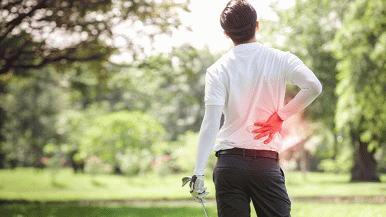Golf is great for reducing stress and anxiety, helping maintain mental alertness and providing physical exercise — walking as well as a full-body workout. Each full swing involves arms, legs, back and abdomen along with movements that include rotation, torque (a twisting force), lateral bending and extension. But while these repeated movements provide a good workout, they also place stress on muscles, tendons and joints and, over time, can result in injury to the lower back, elbow, wrist, hand and shoulder. Carrying a golf bag can also cause injury.
If golf is your favorite sport, there is no need to give it up, according to Arif Saleem, MD, orthopedic surgeon at Rush Orthopaedics & Sports Medicine. He advises that with proper conditioning and the right equipment, you can reduce your risk of injury for a safer game of golf.
The swing and its impact
Examining the mechanics behind a golf swing, Saleem points out that the five phases of a golf swing all have potential impacts on the body.
The first part of the swing is the takeaway – the club moves from a resting position in front of the golfer to a raised position behind the golfer’s head. It involves the shoulder, wrist and back and could possibly cause muscle strain, herniated disc, stress fracture and other issues.
In the forward swing, the club moves from behind the golfer’s head to a horizontal position next to the hip. This movement may impact the shoulder, causing tears. Acceleration is the movement of the club from the hip to the ball. It could cause tears in the hip, repetitive injuries in the wrist and tendon injuries in the elbow.
In early follow-through, the club moves from hitting the ball to swinging out in front of the golfer. This could cause tennis elbow in the lead elbow or golfer’s elbow in the trailing elbow. It could also cause tendon instability in the wrist. The late follow-through part of the swing – from just in front of the golfer to its culmination behind the golfer’s back – could impact the shoulder and knee.
Stretch to help prevent injuries
To protect yourself from these potential injuries, Saleem suggests an assortment of stretches for better and safer golf, including pre- and post-round exercises and conditioning. Before and after a round of golf, he recommends:
- Exercises that focus on low back and hip flexibility to improve spine mobility and stretch and warm up core muscles
- Upper body exercises for the shoulder and forearms
- Lower body stretches for the quadriceps, hamstrings, calf muscles and IT band.
Stretches and exercises specific to hip, foot and ankle, shoulder, knee, and elbow can be found online from the American Academy of Orthopaedic Surgeons.
Condition often
For conditioning, Saleem suggests exercise three to four times per week for 30 minutes to an hour each time to include cardio, muscle conditioning, balance and flexibility. He also recommends spine and core specific exercises, rotator cuff exercises and hip and knee strengthening.
Proper techniques and equipment
In addition, golfers would be wise to consult with a PGA professional for the best techniques and form to match their individual bodies and limitations. Having the proper equipment is also important. A professional club fitter can make sure you have the right size clubs to avoid injury. Lighter shafts and larger grips are available.
Finally, golfers should set goals for practice sessions and limit practice time, focusing on quality rather than quantity.
As with most sports, golf is great exercise but it has the potential to lead to injury and pain. With the proper conditioning, equipment and limits on practice time, you can reduce your risk of injury and enjoy golf and the benefits it provides.
Additional tips
To stay safe while golfing, golfers should also be aware of potential environmental dangers.
- Protect yourself in the sun. Use sunscreen and wear sunglasses and a hat with a visor.
- Pay attention to the weather, especially impending storms. At the first sign of a storm, seek shelter in an enclosed vehicle or permanent building – you are not safe in open areas, small shelters or near trees, poles or other tall objects.
- Stay hydrated. Drink plenty of water before, during and after your round.
- Stay alert. Beware of flying golf balls.




